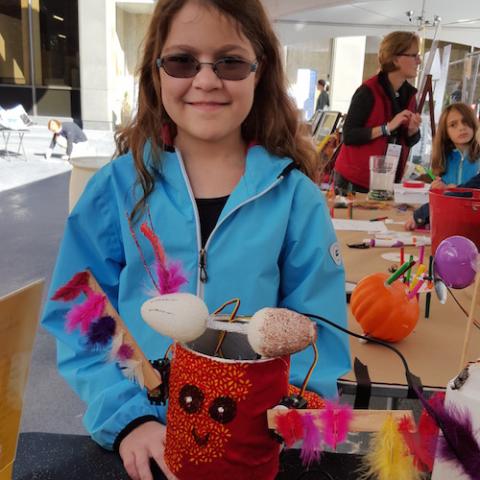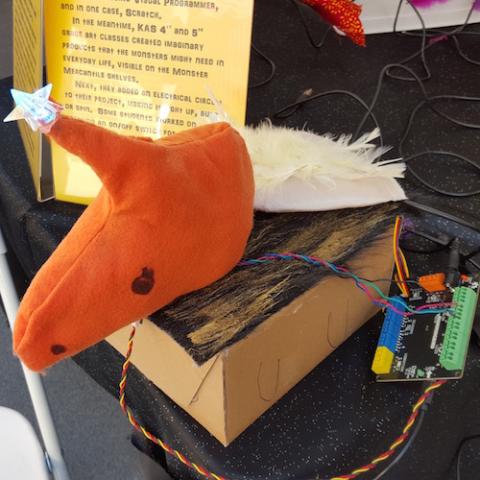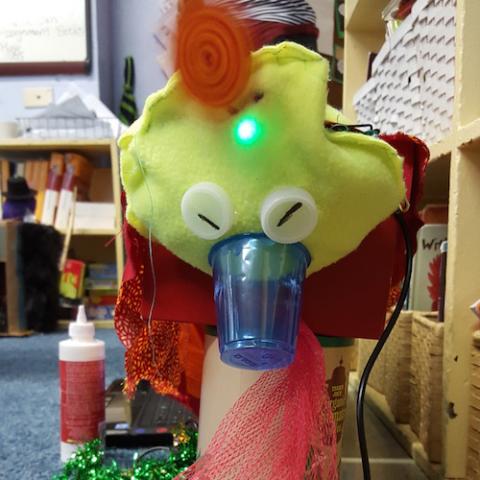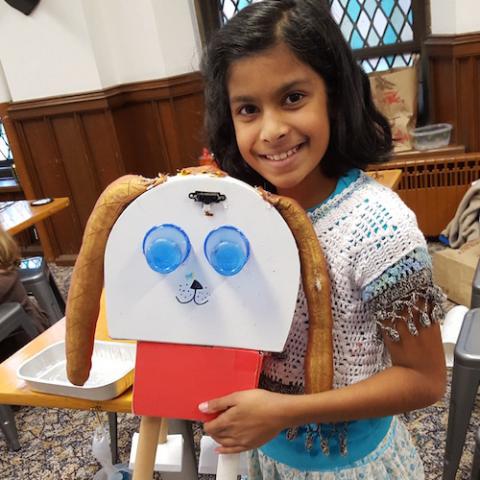Mythological Monster Mashup
Subjects
Social Studies, Language Arts
Project Type
Creatures & Characters
Required Tutorials
Position servo, Rotation servo, Single color LED, & Tri-color LED
Estimated Time
Long (6+ hours)
Description
Use the Hummingbird kit to create robotic versions of monsters from Greek and Roman literature.
Teacher Credit
Aimee Defoe of Kentucky Avenue School in Pittsburgh, PA.
Project Map
Learning Goals
- Students will relate Greek and Roman myths to references in the modern world.
- Students will work in pairs to create a robot that is a combination of different mythological monsters.
- Students will design a control program for their robot using computational thinking.
- Students will test and revise their robot to find and solve problems.
Materials
- Hummingbird Bit Premium Kit
- Possible Craft supplies
Tips
- Have students work in groups of 2-3.
- Our Printables page has a variety of documents for making teaching and learning with Hummingbird easier. Visit and explore resources like the My First Robot Design Notebook now.
Steps
LESSON PROCEDURES:
- Before the robotics portion of the project begins, have students explore mythological monsters in language arts. Read excerpts from the following books:
- Greece! Rome! Monsters! by John Harris
- Greek Myths by Marcia Williams
- D’Aulaires’ Book of Greek Myths by Ingri and Edgar D’Aulaires
- After reading Greek and Roman myths about monsters, have students work as a group to make a list of the features of different monsters. These features might include multiple heads, special powers, etc. Have the class work together to sketch the features of a monster.
- Lead students in a discussion of images from myth in the world around them. This can include making a list of gods, goddesses, and monsters referenced in books, TV shows, and advertisements; it can also include a field trip to the art museum to search for representations of myths.
- This project can also be combined with a unit on the history of ancient Greece.
- This project can also be carried into other subjects. For example, new vocabulary words like “sensors” can be incorporated into spelling lists.
- Before being introduced to the Hummingbird robotics kits, have students work in pairs to create a mashup monster that combines features from different mythological creatures.
- Introduce students to the components of the Hummingbird robotics kit. This can include a demonstration of a sample robot.
- Have students revisit their sketches to consider how they can use robotic components to animate their mashup monster. This project can be simplified for lower elementary students by limiting the number of components that they can use in their monster.
- Introduce students to the idea of computational thinking. This discussion should emphasizes that a program for the robot is a series of step-by-step instructions. Have students give you step-by-step instructions to complete a task within the classroom.
- Before each group begins to build, discuss their sketch and plan with them to ensure that their project is feasible. Remind students to bring in repurposed materials to use for their robot. Parents can also be asked ahead of time to save materials for the project.
- Have students begin to build their mashup monsters.
- For younger students, it may be helpful to have stations for knives and hot glue so that students only use these tools with adult assistance.
- To manage student questions, you may want to use the board or a large sheet of paper to have students sign up for help. This may help to prevent interruptions as you work with other groups.
- As students build, work with each group to show them how to use Snap!, MakeCode, or BirdBlox. Use your sample robot to demonstrate how to use lights, motors, and sensors. With a larger class, whole group instruction may be more appropriate for this step.
- Encourage students to write a short test program for each component as they add it to their robot.
- When students complete their projects, provide an opportunity (such as an open house) for them to share their work with the school community.
Standards Alignment
As an interdisciplinary project focused on Greek and Roman myths, this project meets a number of Common Core standards in language arts (e.g., ELA-LITERACY RL.2.2, RL.2.9, RL.3.2, RL.3.3, RL.4.4, RL.4.9, RL.5.7, and R.L.5.9, among others). In addition, this project is aligned with the elementary engineering standards in the Next Generation Science Standards (3-5-ETS1-1, 3-5-ETS1-2, and 3-5-ETS1-3). This project also incorporates math standards, particularly those involving measurement (2.MD.A, 2.MD.B, 3.MD.A, 4.MD.A, 4.MD.C, and 5.MD.A).




